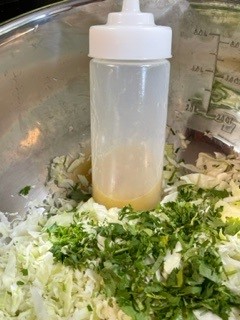
Last month, I started to dive into the world of Burmese cooking. Have you tried my egg curry recipe yet? I got very excited to plummet gracefully from an elevated platform of knowledge with a beautiful smooth swoosh that would ripple with a wave of new information. To my dismay, it has been more like a belly flop at a public pool where everyone around you screams “ouch” as you hit the water.
Okay, it was not that bad. I just had to slow down and go back to the shallow end of the pool before I jumped in.
Usually my go to when I’m researching a food is to find a respected restaurant and have them help me dissect each element. Locally, there is Pa Lian in Wheaton which has rave reviews but unfortunately, I do not live anywhere near them.
So, my next source was online. The descriptions I was finding on Burmese food were oddly similar to any multicultural facetted country. There was a pull from every area to denote a “signature” taste. With Myanmar being bordered by Bangladesh, China, India, Malaysia and Thailand, it was a challenge to narrow down the options of how I’d describe it in writing.
Do I talk about the noodles? The fish? The vegetables? Rice? Is it spicy? Sour? Sweet? Umami driven? I felt like the dishes I was reading about were simple in sense that a lot of the ingredients were common in a lot of households. Yet, there was almost textural playfulness that I needed to try to understand it completely.
The complexity was magnified when I discovered that one of the most celebrated dishes is a tea leaf salad (Lahpet Thoke).
My first thoughts were about the tea leaves. Can you eat tea leaves? Wouldn’t that be super bitter? I really couldn’t comprehend how this ingredient could be balanced with other flavors until I started to experiment in my own kitchen and found how to build this salad in four steps. I will preface that there are a lot of little steps but read through it all and you should be set for success.
Step 1: The Tea Leaves
The first step was learning about the green tea leaves. In Myanmar, young tea leaves are harvested with the intention of fermenting them. It follows the basic principle that food is best when it is freshly picked and utilized. There is a long process of steaming the leaves, removing excess water, packing them under heavy weights and waiting months on end.
Given most of our access to freshly harvested green tea leaves is rare, there is an advantage to not trying to make them at home and buying prepackaged, fermented tea leaves. (Gasp!)
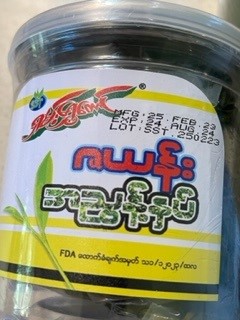 I bought some fermented tea leaves but also found a hack that produced a similar flavor. Technically it was more of a refrigerator pickle process. I felt for the sake of writing it down in a blog, it was a safer alternative than rolling the dice on a fermentation process I’ve never heard of or tried.
I bought some fermented tea leaves but also found a hack that produced a similar flavor. Technically it was more of a refrigerator pickle process. I felt for the sake of writing it down in a blog, it was a safer alternative than rolling the dice on a fermentation process I’ve never heard of or tried.
Pickle the Tea Leaf
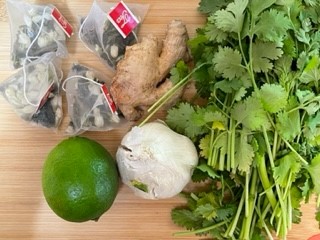
- Steep your favorite high quality green tea leaves for about 7-10 minutes until the leaves expand and soften.
- Drain and squeeze out extra liquid.
- Pick out any tough, stem bits.
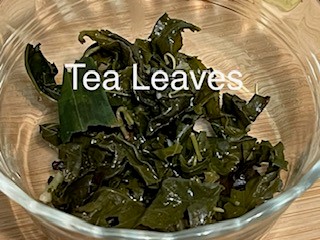
- Mash them up with a mortar and pestle. (Or if you have a cocktail muddler that would probably work too.)
- Rinse with some cold water.
- Drain and squeeze out extra liquid.
- Take a taste. It will taste bitter but not off putting. You can steep it longer and re-rinse if it is still too bitter for your tastes.
- In a small food processor finely chop the tea leaves with salt, garlic, ginger, lime juice and cilantro. (Exact measurements will be in recipe post below.)
- Store in a sanitized jar.
- Cover loosely and ignore for a couple of days.
- Taste and adjust seasoning. Remember when you are tasting it that it is going to be mixed with multiple ingredients that will complement the mild bitter bite.
- Puree again in food processor until you get desired consistency. (Think of the consistency of pesto.) The smell is intoxicatingly wonderful.
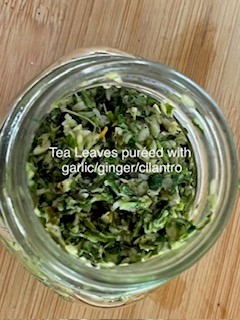
Step: 2 Conquer the Crunch
After you master the tea leaf component, the next thing is to make is the crunch.
The crunch on a tea leaf salad is an exciting mixture of brown garlic slices, peanuts, sesame seeds and some sort of fried or roasted yellow split pea. This is also available to buy premade or in a Tea Leaf Salad kit. Personally, I think the crunch is very personal to your palate so make your own. Think of it like Chex Mix. Yes, there are times you cheat and just buy the premade stuff but we all know Chex Mix is so much better made from scratch. (Now I feel I’m dating myself because I’m not sure if Chex Mix is relevant but I make it!)
The Garlic
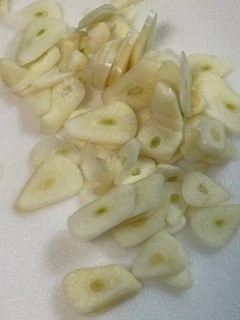
- Slice the garlic as thin as possible.
- Create a “landing” spot for the garlic after it is cooked. This can be paper towels or some brown paper bags.
- Heat 1/3 cup of peanut oil over medium heat in a small but deep skillet.
- Add garlic slices making sure they are not overlapping.
- Lower the heat, the thin garlic is going to go from light tan to dark brown fast. Your goal is for the lighter brown.
- This is one of those times you need to stay attentive to your stovetop and watch. It is going to happen in less than a couple of minutes.
- The key is to notice right when a piece is turning and remove it before it gets dark.
- I plucked each piece out with a kitchen utensil that had a long handle.
- Place on paper towels to drain.
- Set aside.
- If you accidently burn a few slices, pick those out and pitch them.
- Reserve the leftover garlic oil.
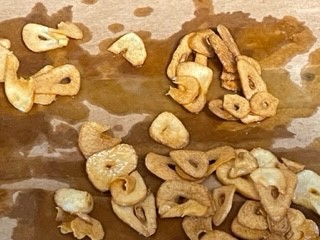 The split peas were the challenging element of the crunch. You need to have the time and forethought to allow them to soak for at least 4+ hours.
The split peas were the challenging element of the crunch. You need to have the time and forethought to allow them to soak for at least 4+ hours.
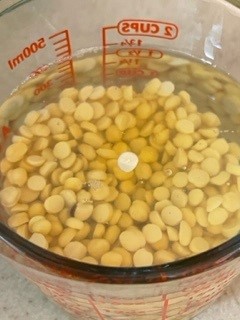 Next, you must drain and dry them off enough to fry them up.
Next, you must drain and dry them off enough to fry them up.
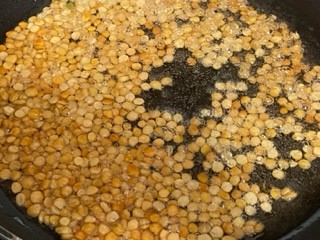 If there is any water left in them, they pop aggressively at you and scare the dog. Drain off oil and set aside.
If there is any water left in them, they pop aggressively at you and scare the dog. Drain off oil and set aside.
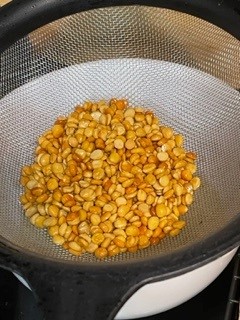 Personally, their contribution to the crunch wasn’t satisfying enough for me to warrant the time. I made them but they were almost off putting to me because the crunch was a little too hard to be pleasant. I decided this was an okay ingredient to substitute.
Personally, their contribution to the crunch wasn’t satisfying enough for me to warrant the time. I made them but they were almost off putting to me because the crunch was a little too hard to be pleasant. I decided this was an okay ingredient to substitute.
My vote was to make a crunchy chickpea. This was where being a home cook was an advantage. You can always adjust authenticity with personal preference.
Chickpea alternative (not pictured)
- Drain and rinse one 14-ounce can of chickpeas
- Heat garlic oil leftover from browning garlic slices over a medium/high heat.
- Add the chickpeas.
- Move them around with a spatula to prevent them from burning, cook until they are golden. It was about 5-8 minutes. If they are turning brown too fast, lower your heat.
- Season with a sprinkle of salt. Set aside.
Step 3: Extra Vinaigrette
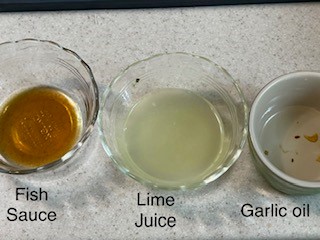 When looking at recipes for guidance, I saw various instructions that included fish sauce, lime juice and the reserved garlic oil. I read that as all the components of a basic vinaigrette. I drizzled the garlic oil into an equal amount of lime juice and about 1 tablespoon of fish sauce. I took a taste and added one more dash of the fish sauce to make it saltier. I put it in a squeeze bottle and set it aside.
When looking at recipes for guidance, I saw various instructions that included fish sauce, lime juice and the reserved garlic oil. I read that as all the components of a basic vinaigrette. I drizzled the garlic oil into an equal amount of lime juice and about 1 tablespoon of fish sauce. I took a taste and added one more dash of the fish sauce to make it saltier. I put it in a squeeze bottle and set it aside.
Step 4: The Build
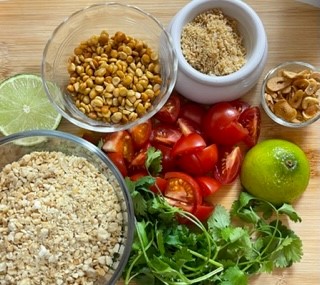 The tradition with tea leaf salad is to present it with all the different components separated and then mix it together in a feast of celebration and gratitude. This ideology of this is beautiful if you have a large enough serving receptacle.
The tradition with tea leaf salad is to present it with all the different components separated and then mix it together in a feast of celebration and gratitude. This ideology of this is beautiful if you have a large enough serving receptacle.
I made individual salads in our household that still honored the authenticity of the dish while making it more approachable for the audience at hand. (In other words, my husband and dog).
This is the easiest part.
- Shred a head of green cabbage (or you can use your favorite hearty lettuce like romaine or iceberg).
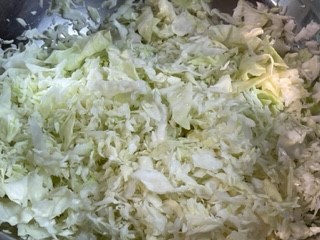
- Toss the cabbage with half of the tea leaf mixture making sure you reserve half.
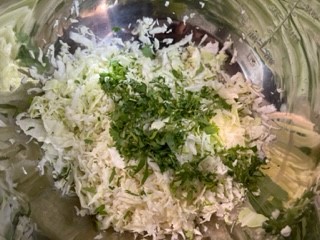
- Place the tossed cabbage in individual bowls.
- Add a dollop of the tea leaf mixture in the center.
- Arrange the remaining ingredients decoratively in the bowl.
- Drizzle some of the vinaigrette on top and serve.
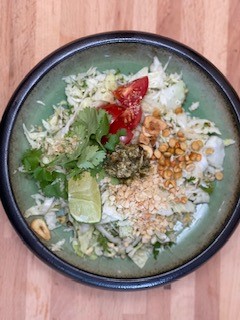 Final thoughts: this salad did have a lot of components but it was so fabulous. The bitterness of the tea leaves was somehow finessed into a sharp, bright, texturally delightful component of a meal. The salad definitely created the perfect splash so I do see myself continuing to wade into some of the diverse pools of multicultural cuisine.
Final thoughts: this salad did have a lot of components but it was so fabulous. The bitterness of the tea leaves was somehow finessed into a sharp, bright, texturally delightful component of a meal. The salad definitely created the perfect splash so I do see myself continuing to wade into some of the diverse pools of multicultural cuisine.
Tea Leaf Salad
Scroll down for a printable version of this recipe
Serves: 4 as a main dish, 8 as an appetizer
Active time: 25 minutes
Inactive Time: 2 days
For the pickled tea leaves (2 days lead time) (1/2 cup of dressing)
3 Tablespoons of high quality green tea leaves
2 cups of boiling water
2-4 cloves of garlic (I had about a heaping tablespoon of garlic. It is going to be raw so you can use less per your tastes).
1 teaspoon fresh ginger
1 cup of cilantro leaves (and fine stems)
1/2 teaspoon of salt
Juice from one lime
For the salad
1 head of green cabbage, shredded (about 4 cups)
2 cups of chopped tomatoes
1/2 cup of fried garlic (This was about a half a head of garlic. *Reserve the oil during preparation.)
1/2 cup toasted peanuts, chopped
1/2 cup of fried yellow split peas**
1 Tablespoon toasted sesame seeds
2 Tablespoons of dried shrimp powder, optional (Dried shrimp is sold in small bags in a lot of grocery stores. Pulsed in a food processor produces a delightfully fluffy powder that adds a nice umami bomb to the finished dish.)
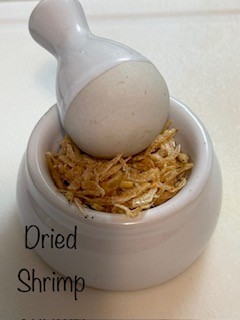
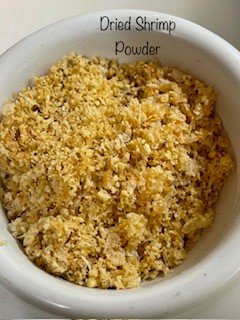
Extra Vinaigrette
3 Tablespoons of garlic peanut oil
1 Tablespoon of lime juice
1 teaspoon of fish sauce
2 days ahead of serving meal: Part 1: Prepare Pickled Tea Leaves
- Sterilize one small canning jar.
- In a heat proof container, steep your favorite high quality green tea leaves for about 7-10 minutes until the leaves expand and soften.
- Drain and squeeze out extra liquid.
- Pick out any tough, stem bits.
- Mash them up with a mortar and pestle. (Or if you have a cocktail muddler that would probably work too.)
- Rinse with some cold water.
- Drain and squeeze out extra liquid.
- In a small food processor, add the tea leaves, garlic, ginger, cilantro, salt and lime juice. Pulse until you have the desired consistency.
- Store in the canning jar.
- Cover loosely and place it in the refrigerator for 2 days or until all the flavors meld together. (Why 2 days? Because I tasted after day 1 and it was still too bitter but it mellowed on day 2.)
Part 2: Vinaigrette
In a small container, whisk together lime juice and fish sauce. Whisk in the garlic oil slowly. This will be a temporary emulsion so you may have to mix it again before serving.
Part 3: Assemble Salad Bowls
- In a large bowl, toss cabbage with part of the prepared pickled tea leaves. (I used about a little less than 1/4 of a cup.)
- Lay out individual salad bowls for serving.
- Place about 1 cup of the cabbage in each bowl, if you are making 4 servings as a meal. (Use 1/2 cup of the cabbage if making side salads.)
- Make a tiny well in the center and add a dollop of the remaining dressing into each bowl.
- Decoratively place the chopped tomatoes, fried garlic, peanuts, fried split peas (or fried chickpeas) and sesame seeds.
- Sprinkle with shrimp powder, if using.
- Serve with the vinaigrette tableside so people can add a little more flavor if desired.
- Encourage people to vigorously mix their bowls up before diving in.
If I have learned anything in my years of attending classes at The Chopping Block, it is that there are so many more areas of the culinary world to explore. Take the opportunity to keep learning about a favorite topic by scheduling a private virtual lesson. During a Zoom session, you will have a chef all to yourself to help walk you through your own cooking challenges. (I might need one to master those fried yellow split peas!).
If you are the hunt for more exotic bold flavors to add to your cooking, don't miss our Hands-On Taste of Thailand class on Friday, September 22 at 6pm at Lincoln Square. You'll learn to make:
- Tom Kha Gai (Spicy Chicken and Coconut Milk Soup)
- Tod Mun Pla (Thai Fish Cakes) with Sweet and Spicy Cucumber Relish
- Grilled Thai Beef Noodle Salad with Chili-Lime Vinaigrette
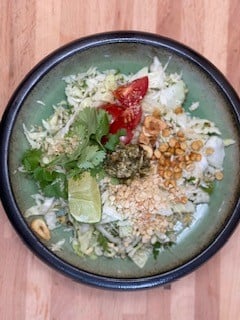
Tea Leaf Salad
Ingredients
- 3 Tablespoons of high quality green tea leaves
- 2 cups of boiling water
- 2-4 cloves of garlic (I had about a heaping tablespoon of garlic. It is going to be raw so you can use less per your tastes).
- 1 teaspoon fresh ginger
- 1 cup of cilantro leaves (and fine stems)
- 1/2 teaspoon of salt
- Juice from one lime
- 1 head of green cabbage, shredded (about 4 cups)
- 2 cups of chopped tomatoes
- 1/2 cup of fried garlic (This was about a half a head of garlic. *Reserve the oil during preparation.)
- 1/2 cup toasted peanuts, chopped
- 1/2 cup of fried yellow split peas
- 1 Tablespoon toasted sesame seeds
- 2 Tablespoons of dried shrimp powder, optional
- 3 Tablespoons of garlic peanut oil
- 1 Tablespoon of lime juice
- 1 teaspoon of fish sauce
Instructions
- Sterilize one small canning jar.
- In a heat proof container, steep your favorite high quality green tea leaves for about 7-10 minutes until the leaves expand and soften.
- Drain and squeeze out extra liquid.
- Pick out any tough, stem bits.
- Mash them up with a mortar and pestle. (Or if you have a cocktail muddler that would probably work too.)
- Rinse with some cold water.
- Drain and squeeze out extra liquid.
- In a small food processor, add the tea leaves, garlic, ginger, cilantro, salt and lime juice. Pulse until you have the desired consistency.
- Store in the canning jar.
- Cover loosely and place it in the refrigerator for 2 days or until all the flavors meld together. (Why 2 days? Because I tasted after day 1 and it was still too bitter but it mellowed on day 2.)
- In a small container, whisk together lime juice and fish sauce. Whisk in the garlic oil slowly. This will be a temporary emulsion so you may have to mix it again before serving.
- In a large bowl, toss cabbage with part of the prepared pickled tea leaves. (I used about a little less than 1/4 of a cup.)
- Lay out individual salad bowls for serving.
- Place about 1 cup of the cabbage in each bowl, if you are making 4 servings as a meal. (Use 1/2 cup of the cabbage if making side salads.)
- Make a tiny well in the center and add a dollop of the remaining dressing into each bowl.
- Decoratively place the chopped tomatoes, fried garlic, peanuts, fried split peas (or fried chickpeas) and sesame seeds.
- Sprinkle with shrimp powder, if using.
- Serve with the vinaigrette tableside so people can add a little more flavor if desired.
- Encourage people to vigorously mix their bowls up before diving in.

